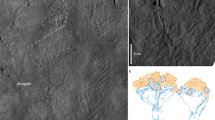Summary
An examination of all specimens of the Cnidarian genusConomedusites Glaessner & Wade from the Late Precambrian Pound Quartzite of Ediacara, South Australia, leads to the conclusion that it is closely related to the Ordovician genusConchopeltis Walcott. A consideration of the Conulata to which these genera were assigned suggests that their distinctive evolutionary trend is not part of the diversification of the Scyphozoa. The Conchopeltida appear to be intermediate between the primitive Hydrozoa (from which, through a similar development of an important chitinous structure the Chondrophora evolved) and the Scyphozoa. Adaptations of the polyp and medusa forms are largely independent and in different lineages of Cnidaria either one can be more advanced;Conomedusites, Conchopeltis and the Conulariida are polyps. The Anthozoa separated in the Precambrian from their common ancestors with the Hydrozoa.
Zusammenfassung
Die Untersuchung der verfügbaren Exemplare der Cnidarier-GattungConomedusites Glaessner & Wade (Jung-Präkambrium, Pound Quarzit, Ediacara, Südaustralien) zeigte ihre nahe Verwandtschaft mit der GattungConchopeltis Walcott (Ordoviz). Betrachtungen über die Conulata, zu denen diese Gattungen gestellt werden, führen zu dem Schluß, daß sie wegen ihrer bezeichnenden Entwicklungsrichtung nicht zu den Scyphozoa gehören. Die Conchopeltida (als primitive Conulata) vermitteln zwischen den primitiven Hydrozoen (aus denen durch eine ähnliche Entwicklung von adaptiv bedeutsamen Chitinstrukturen die Chondrophora hervorgingen) und den Scyphozoen. Die Evolution der Polypen- und der Medusenformen sind weitgehend unabhängige Vorgänge;Conomedusites, Conchopeltis und die Conulariida werden als Polypenformen aufgefaßt. Die Anthozoa haben sich schon im Präkambrium aus den gemeinsamen Ahnenformen mit den Hydrozoen entwickelt, also vor den Scyphozoen.
Similar content being viewed by others
References
Bouillon, J. (1968): Introduction to Coelenterates. — In:Florkin, M. &Scheer, B. T.: Chemical Zoology,2, 81–147, New York & London (Acad. Press).
Caster, K. E. (1942): Two Siphonophores from the Paleozoic. — Palaeontographica Amer.,3 (14), 61–86.
Chapman, D. M. (1966): Evolution of the Scyphistoma. — In: The Cnidaria and their Evolution (W. J. Rees, ed.), Sympos. Zool. Soc. London,16, 51–75.
Delsman, H. C. (1923): Beiträge zur Entwicklungsgeschichte von Porpita. — Treubia,III, 243–266, Buitenzorg.
Glaessner, M. F. &Wade, M. (1966): The late Precambrian fossils from Ediacara, South Australia. — Palaeontology,9 (4), 599–628.
Gutmann, W. F. (1965): Rückstoß und Ruderschlag der Quallen. — Natur u. Museum,95, 455–462, Frankfurt a. M.
— (1966): Zu Bau und Leistung von Tierkonstruktionen (4–6). — Abh. senckenb. naturf. Ges.,510, 5–104, Frankfurt a. M.
Hand, C. (1963): The Early Worm: A Planula. — In: The Lower Metazoa (Dougherty, E. C. et al., eds.), 33–39, Univ. Calif. Press.
Huckriede, R. (1967):Archaeonectris benderi n. gen. n. sp., (Hydrozoa), eine Chondrophore von der Wende Ordovicium/Silurium aus Jordanien. — Geologica et Palaeontologica,1, 101–109, Marburg a. L.
Hyman, L. H. (1940): The Invertebrates: protozoa through Ctenophora.I, 726 p. New York (McGraw-Hill Book Co., Inc.).
— (1959): The Invertebrates: Smaller Coelomate Groups.V. — 783 p., New York (McGraw-Hill Book Co., Inc.).
Kiderlen, H. (1937): Die Conularien. Über Bau und Leben der ersten Scyphozoa. — N. Jb. Miner. Geol. Pal., Abh. (B),77, 113–169, Stuttgart.
Knight, J. B. (1939):Conchopeltis Walcott, an Ordovician Genus of the Conulariida. — J. Paleont.,11, 186–188.
Korde, K. B. (1963): Hydroconozoa, a new class of Coelenterata. — Palaeont. J.,2, 20–25, Moscow. [In Russian].
Kozlowski, R. (1968): Nouvelles Observations sur les Conulaires. — Acta palaeont. polon.,8, 497–529, Warszawa.
Leloup, E. (1954): A propos des Siphonophores. — Inst. roy. Sci. natur. belg., vol. jubil.Victor van Straelen, 1925–1954,2, IV.Zool., 643–699, Bruxelles.
Mackie, G. O. (1959): The Evolution of the Chondrophora (Siphonophora-Disconanthae): New Evidence from Behavioural Studies. — Proc. Trans. roy. Soc. Canada,53, Ser. 3, 7–20.
Madsen, F. J. (1956):Eldonia A Cambrian Siphonophore — Formerly Interpreted as a Holothurian. — Videns. K. Medd. dansk naturhist. Foren.,118, 7–14, København.
Manton, S. M. (1941): On the Hydrorhiza and Claspers of the HydroidMyriothela cocksi (Vigurs). — J. Mar. Biol. Assoc. U. K.,25, 143–150.
Moore, R. C. & Harrington, H. J. (1956): Scyphozoa. Conulata. — In: Treatise on Invertebrate Paleontology (Moore, R. C., ed.), pt.F, 27–53, 54–66, Lawrence (Kansas).
Osgood, R. J. Jr. (1970): Trace fossils of the Cininnati area. — Palaeontogr. Amer.,6 (41), 281–444.
Thiel, H. (1966): The Evolution of Scyphozoa. A Review. — In: The Cnidaria and their Evolution (W. J. Rees, ed.), Sympos. Zool. Soc. London,16, 77–117.
Wade, M. (1969): Medusae from uppermost Precambrian or Cambrian sandstones, central Australia. — Palaeontology,12, 351–365, London.
Wade, M. (1971): Bilateral Precambrian Chondrophores from the Ediacara Fauna, South Australia. — Proc. roy. Soc. Victoria, in press.
Werner, B. (1966):Stephanoscyphus (Scyphozoa, Coronatae) und seine direkte Abstammung von den fossilen Conulata. — Helgoländer wiss. Meeresunters.,13, 317–347, Heide (Holst.).
— (1967a): Morphologie, Systematik und Lebensgeschichte vonStephanoscyphus (Scyphozoa Coronatae) sowie seine Bedeutung für die Evolution der Scyphozoa. — Zool. Anz., Suppl.30, 297–319.
— (1967b):Stephanoscyphus Allman (Scyphozoa Coronatae), ein rezenter Vertreter der Conulata? — Paläont. Z.,41, 137–153, Stuttgart.
Author information
Authors and Affiliations
Additional information
With Plate 1 and 2 Text-figures
This research was supported by an Australian Research Grant.
Rights and permissions
About this article
Cite this article
Glaessner, M.F. The genusConomedusites Glaessner & Wade and the diversification of the Cnidaria. Paläont. Z. 45, 7–17 (1971). https://doi.org/10.1007/BF02989671
Issue Date:
DOI: https://doi.org/10.1007/BF02989671




